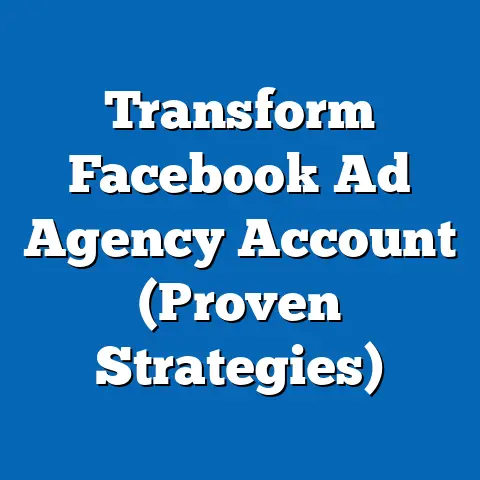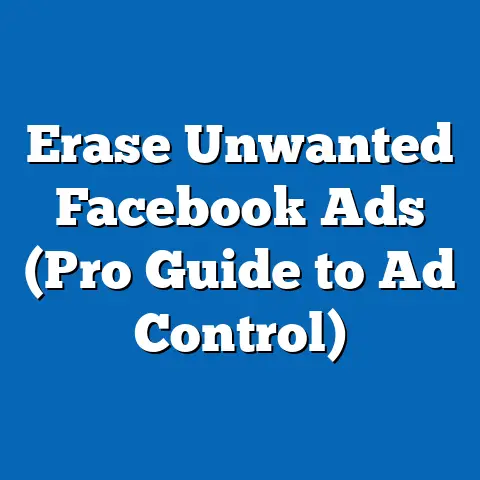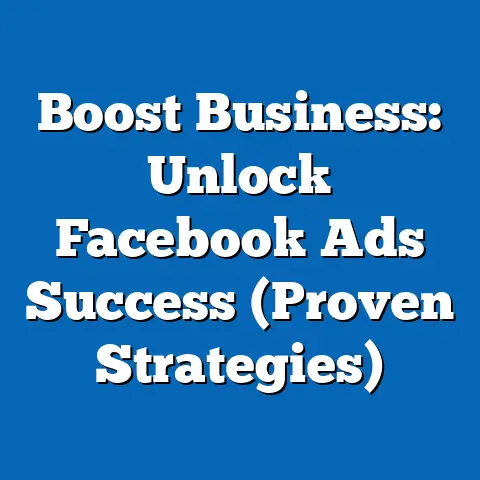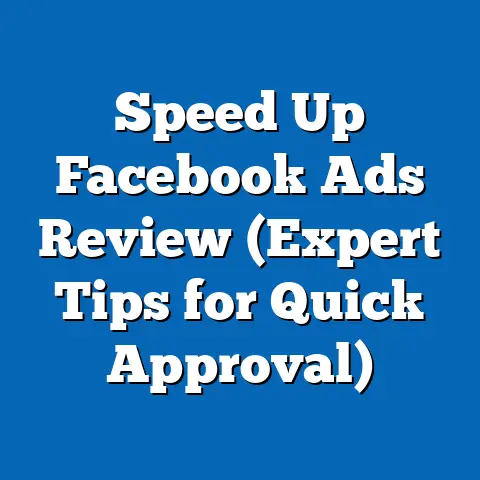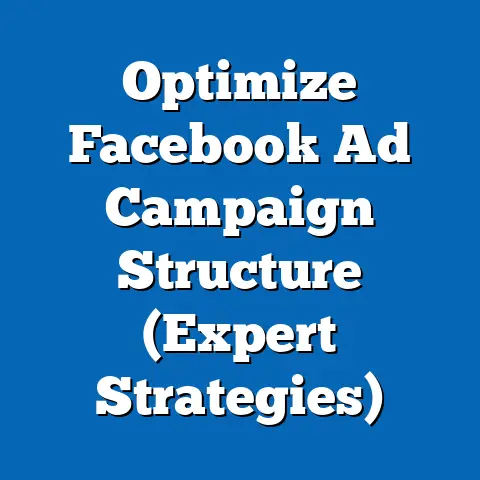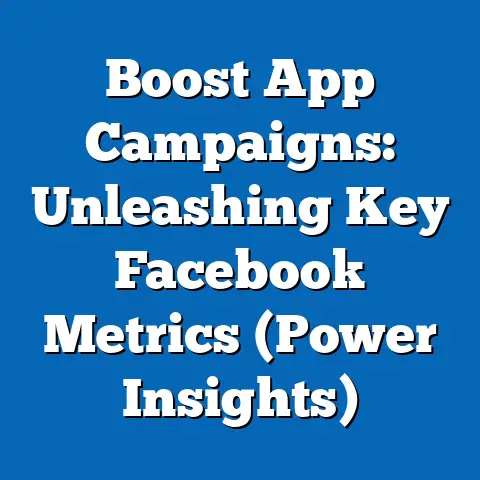Maximize fb ad Reach (Proven Strategies Revealed)
In the ever-evolving landscape of digital marketing, achieving maximum reach on Facebook ads remains a top priority for businesses and marketers. With over 2.9 billion monthly active users as of 2023, according to Statista, Facebook offers an unparalleled platform to connect with diverse audiences worldwide. However, standing out in a crowded digital space requires strategic planning, data-driven decisions, and a deep understanding of user behavior.
Tapping Into Seasonal Trends: A Gateway to Greater Reach
Seasonal trends play a pivotal role in shaping consumer behavior, and leveraging these patterns can significantly boost your Facebook ad reach. According to a 2022 report by Sprout Social, 74% of consumers are more likely to engage with brands that align their messaging with seasonal events or holidays. This highlights the importance of timing and relevance in ad campaigns.
Major seasonal events like Black Friday, Christmas, and Back-to-School periods often see spikes in online activity. For instance, Adobe Analytics reported that U.S. online sales during the 2022 holiday season (November to December) reached $211.7 billion, a 3.5% increase from the previous year. This surge in online engagement presents a prime opportunity for advertisers to capture attention on platforms like Facebook.
Demographically, seasonal trends impact different groups in unique ways. A 2023 study by Nielsen found that Millennials (ages 27-42) and Gen Z (ages 11-26) are the most active during holiday shopping seasons, accounting for 60% of online purchases during Black Friday and Cyber Monday. In contrast, Baby Boomers (ages 59-77) tend to engage more during non-holiday seasonal events, such as spring home improvement sales, with 45% of this demographic responding to targeted ads for such products.
Historically, seasonal ad campaigns have shown consistent success on Facebook. Data from Meta’s own advertising insights reveals that brands running holiday-specific campaigns in Q4 of 2021 saw a 22% higher click-through rate (CTR) compared to non-seasonal ads in the same period. This trend underscores the need to tailor content to seasonal contexts, whether through festive visuals, limited-time offers, or holiday-themed messaging.
Methodology and Data Source: The above statistics are sourced from industry reports by Sprout Social, Adobe Analytics, Nielsen, and Meta’s advertising platform. These organizations use a combination of user surveys, transaction tracking, and platform analytics to compile their data, ensuring reliability and relevance for marketers. Cross-referencing these sources helps account for variances in demographic behavior and seasonal spending patterns.
Understanding the Importance of Facebook Ad Reach
Before diving into specific strategies, it’s crucial to define what “reach” means in the context of Facebook advertising. Reach refers to the number of unique users who see your ad at least once during a campaign. According to Meta, the average cost per thousand impressions (CPM) on Facebook in 2023 is approximately $7.19, though this varies by industry, audience targeting, and seasonality.
Maximizing reach is essential for brand awareness, lead generation, and ultimately, conversions. A 2022 study by Hootsuite found that 58% of marketers cite “increasing brand visibility” as their primary goal for social media advertising. However, with Facebook’s algorithm prioritizing user engagement over sheer exposure, achieving high reach requires a blend of creativity, data analysis, and strategic planning.
Compared to historical data, the challenge of reaching audiences has grown. In 2018, organic reach for business pages on Facebook averaged around 6.4% of a page’s followers, per a study by Socialbakers. By 2023, this figure dropped to just 2.5%, reflecting the platform’s shift toward paid advertising and user-relevant content. This decline emphasizes the importance of paid ad strategies to ensure visibility.
Demographic Insight: Reach varies significantly by audience segment. For instance, Meta’s 2023 data indicates that ads targeting users aged 18-24 achieve a 15% higher reach compared to those targeting users aged 55+, largely due to younger users’ higher platform engagement (averaging 2.5 hours daily). Tailoring campaigns to demographic behavior is, therefore, a key factor in maximizing exposure.
Strategy 1: Crafting Seasonal Campaigns with Precision
Building on the importance of seasonal trends, the first proven strategy is to design campaigns that resonate with specific times of the year. A 2023 report by Social Media Today revealed that 68% of Facebook users are more likely to click on ads that feature seasonal themes, such as Halloween costumes in October or Valentine’s Day promotions in February.
To execute this, start by identifying key seasonal events relevant to your audience. For example, e-commerce brands can capitalize on Cyber Monday, which saw $12.4 billion in U.S. online sales in 2022, per Adobe Analytics. Creating urgency with countdown timers or phrases like “24 Hours Only” can further drive engagement, as 53% of users report FOMO (fear of missing out) as a motivator for clicking on time-sensitive ads, according to a Sprout Social survey.
Practical Tip: Use Facebook’s Audience Insights tool to analyze when your target demographic is most active. For instance, parents shopping for Back-to-School supplies often peak in late July to early August, with search volume increasing by 35% during this period, per Google Trends data. Aligning ad schedules with these spikes ensures higher visibility.
Visualization Description: Imagine a line graph showing seasonal engagement peaks on Facebook, with spikes during November (holiday shopping), February (Valentine’s Day), and August (Back-to-School). Overlaying this with ad spend data would illustrate the correlation between timing and reach, making the impact of seasonal campaigns visually clear.
Strategy 2: Leveraging Advanced Audience Targeting
Facebook’s robust targeting options allow advertisers to hone in on specific demographics, interests, and behaviors, directly impacting ad reach. As of 2023, Meta reports that ads using detailed targeting options achieve a 30% higher reach compared to broad, untargeted campaigns. This is because tailored ads are more likely to be deemed relevant by the algorithm, thus being shown to more users.
One effective method is lookalike audiences, which target users similar to your existing customers. A 2022 case study by Meta showed that businesses using lookalike audiences saw a 25% increase in reach and a 20% reduction in cost per acquisition (CPA). This approach works particularly well when paired with seasonal campaigns, as it ensures ads reach users with a proven interest in similar products or services.
Demographic Patterns: Gender and age play significant roles in targeting success. For example, women aged 25-34 are 18% more likely to engage with ads for beauty and fashion during holiday seasons, per Nielsen data, while men aged 35-54 show higher engagement with tech and automotive ads during the same period. Understanding these nuances allows for more precise ad delivery.
Methodology: To create effective lookalike audiences, upload a customer list or use data from website pixel tracking to Facebook’s Ads Manager. The platform then identifies common traits among these users to build a broader, yet relevant, audience pool. Regularly updating this data ensures alignment with changing consumer behaviors, especially during seasonal shifts.
Strategy 3: Optimizing Creative Content for Engagement
Content is king when it comes to maximizing reach, as engaging visuals and copy can significantly boost ad performance. According to a 2023 report by HubSpot, video ads on Facebook achieve 135% higher organic reach compared to static image ads. Furthermore, ads with clear calls-to-action (CTAs) like “Shop Now” or “Learn More” see a 28% higher CTR, per Meta’s internal data.
Seasonal creativity is particularly impactful. For instance, a holiday-themed video ad featuring festive music and visuals can resonate more than a generic promotion. A 2022 study by Sprout Social found that 62% of users are more likely to share seasonal content with friends, amplifying organic reach beyond paid impressions.
Historical Comparison: In 2019, image-based ads dominated Facebook advertising, with 75% of campaigns using static visuals, per Socialbakers. By 2023, this shifted to 60% of campaigns incorporating video, reflecting user preference for dynamic content. Marketers who adapt to these trends are better positioned to capture attention.
Practical Tip: Test multiple ad formats using Facebook’s A/B testing feature. For example, run a carousel ad alongside a video ad for a holiday campaign and measure which garners higher reach and engagement. Data from these tests can inform future creative decisions, ensuring continuous optimization.
Visualization Description: Picture a bar chart comparing the reach of different ad formats (video, image, carousel) across seasonal and non-seasonal campaigns. Highlighting video’s dominance during holiday periods would visually reinforce the importance of format in driving reach.
Strategy 4: Budget Allocation and Bidding Strategies
Effective budget management is critical to maximizing ad reach, especially during high-competition seasonal periods. Meta reports that CPM rates during Q4 (October to December) increase by an average of 39% due to heightened demand. Planning ahead and allocating a larger portion of your budget to these peak times can prevent your ads from being outbid.
One proven approach is using Facebook’s Campaign Budget Optimization (CBO), which automatically distributes your budget across ad sets to prioritize high-performing audiences. A 2023 study by WordStream found that campaigns using CBO saw a 15% increase in reach compared to manual budget allocation. This is particularly useful during seasonal spikes when audience behavior fluctuates rapidly.
Historical Trend: In 2020, the average CPM during the holiday season was $5.80, per Meta data. By 2023, this rose to $7.19, reflecting increased competition and platform growth. Adjusting bidding strategies, such as opting for cost-per-click (CPC) over CPM during peak seasons, can help manage costs while maintaining reach.
Demographic Consideration: Budget allocation should also account for demographic engagement costs. Ads targeting Gen Z users often have a 10% lower CPM compared to older demographics, per Meta’s 2023 insights, due to higher competition for older audiences in certain industries. Tailoring bids to these differences can optimize spend.
Strategy 5: Timing and Frequency for Maximum Exposure
Timing your ads correctly is just as important as creative content or targeting. According to a 2023 report by Sprout Social, the best times to post ads on Facebook are weekdays between 1-3 PM and 7-9 PM, when user activity peaks. Scheduling ads during these windows can increase reach by up to 20%.
Frequency, or how often users see your ad, also impacts performance. Meta recommends a frequency cap of 2-3 impressions per user per week to avoid ad fatigue, which can reduce reach by 40% if overexposed, per a 2022 study by Social Media Examiner. Balancing frequency with fresh creative updates ensures sustained engagement.
Seasonal Timing: During holiday seasons, user activity often shifts to evenings and weekends. For instance, Black Friday data from 2022 shows a 30% increase in Facebook logins between 6-10 PM, per Hootsuite analytics. Adjusting ad schedules to match these patterns can capture more eyeballs.
Practical Tip: Use Facebook’s Insights tool to monitor when your specific audience is online, as timing varies by demographic. For example, Gen Z users are more active late at night, with 45% engaging after 10 PM, per Nielsen data. Customizing schedules to these habits maximizes exposure.
Strategy 6: Harnessing the Power of Retargeting
Retargeting, or re-engaging users who have previously interacted with your brand, is a powerful tool for boosting reach and conversions. A 2023 report by Criteo found that retargeted ads on Facebook have a 70% higher CTR compared to initial ads, as they target users already familiar with your brand.
During seasonal campaigns, retargeting can remind users of abandoned carts or limited-time offers. For instance, e-commerce brands using retargeting during the 2022 holiday season saw a 35% increase in conversions, per Meta data. Combining retargeting with dynamic ads—automatically showing products users viewed—further enhances relevance and reach.
Demographic Insight: Retargeting effectiveness varies by age group. Millennials are 25% more likely to respond to retargeted ads compared to Baby Boomers, per Nielsen’s 2023 findings, likely due to differences in online shopping habits. Adjusting retargeting frequency and messaging to these patterns can optimize results.
Methodology: Implement retargeting by installing the Facebook Pixel on your website to track user actions. Create custom audiences based on behaviors like page visits or cart abandonment, then serve tailored ads. Regularly analyze performance metrics to refine these campaigns for maximum impact.
Strategy 7: Measuring and Iterating for Continuous Improvement
No strategy is complete without measurement and iteration. Facebook’s Ads Manager provides detailed metrics on reach, impressions, CTR, and more, allowing marketers to assess campaign performance in real-time. A 2023 study by HubSpot found that brands that regularly analyze and adjust their campaigns achieve a 40% higher reach over static campaigns.
Focus on key performance indicators (KPIs) aligned with your goals. For reach-focused campaigns, monitor impressions and frequency to ensure broad exposure without oversaturation. For seasonal campaigns, track engagement metrics like shares and comments, as 55% of holiday shoppers share deals with friends, per Sprout Social data.
Historical Comparison: In 2018, only 30% of small businesses used analytics tools to measure Facebook ad performance, per Socialbakers. By 2023, this rose to 65%, reflecting a growing reliance on data-driven decision-making. Marketers who embrace this trend are better equipped to adapt to changing user behaviors.
Practical Tip: Set up weekly performance reviews to identify underperforming ads. For example, if a holiday ad’s CTR drops below 1% after two days, consider refreshing the creative or adjusting the audience. Continuous optimization ensures sustained reach throughout a campaign.
Visualization Description: Envision a dashboard-style chart displaying KPIs like reach, CTR, and cost per impression over a seasonal campaign timeline. Highlighting spikes during key dates (e.g., Black Friday) would visually demonstrate the impact of timing and iteration on performance.
Broader Implications and Future Trends
Maximizing Facebook ad reach is not just about immediate results; it’s about building a sustainable digital presence in an increasingly competitive space. As user behaviors shift and platform algorithms evolve, strategies like seasonal targeting, advanced audience segmentation, and data-driven iteration will remain critical. The rise of video content and dynamic retargeting also points to a future where personalization and engagement are paramount.
Looking ahead, emerging technologies like AI-driven ad optimization and augmented reality (AR) experiences could further transform how brands achieve reach on Facebook. A 2023 forecast by eMarketer predicts that 50% of social media ad spend will incorporate AI tools by 2025, suggesting a shift toward automation and hyper-targeted campaigns. Staying ahead of these trends will be essential for marketers aiming to maintain a competitive edge.
Seasonal trends, as highlighted at the outset, will continue to shape advertising success. With online holiday sales projected to exceed $250 billion by 2025, per Adobe Analytics, the opportunity to connect with audiences during peak periods will only grow. By combining the strategies outlined in this article—ranging from precise targeting to creative optimization—brands can not only maximize reach but also build lasting relationships with their audiences.
In conclusion, achieving maximum Facebook ad reach requires a multifaceted approach grounded in data, creativity, and adaptability. As the digital landscape evolves, those who leverage seasonal insights, embrace demographic nuances, and prioritize continuous improvement will be best positioned to thrive. Whether you’re gearing up for the next holiday season or planning a year-round campaign, these proven strategies offer a roadmap to success in the dynamic world of social media advertising.

